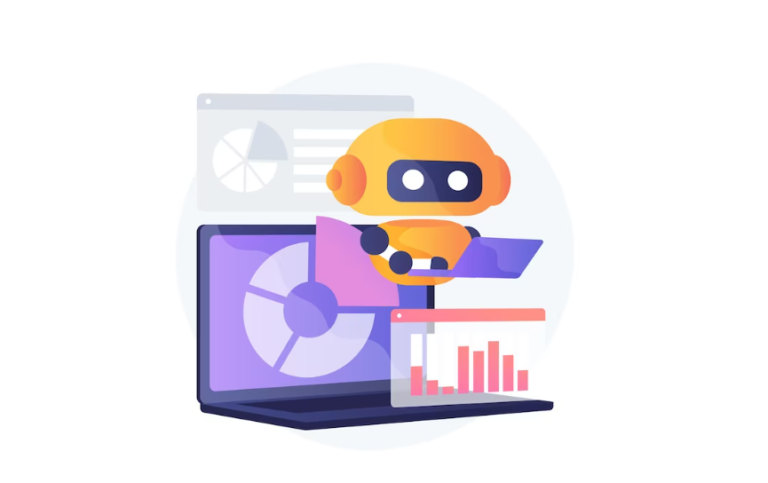
Redesigning Business Processes with AI: Benefits and Applications
Artificial intelligence (AI) is changing the way businesses operate. By automating tasks, AI can streamline business processes, reducing costs, and increasing efficiency. In this article, we will explore the benefits of redesigning business processes with AI and the applications of AI in various industries.
The role of AI in business process redesign
Artificial Intelligence (AI) is playing an increasingly important role in the redesign of business processes. AI technology can automate tasks that were previously performed by humans, leading to increased efficiency, reduced costs, and improved accuracy. By using AI to analyze data and make predictions, businesses can make more informed decisions and optimize their operations.
AI can be used in a variety of ways to redesign business processes. For example, in customer service, chatbots can be used to interact with customers and provide support, freeing up human agents to focus on more complex issues. In finance, AI can be used to automate repetitive tasks such as data entry and processing, reducing the risk of errors and increasing efficiency.
AI can also be used to optimize supply chain operations, predicting demand and optimizing inventory levels to reduce waste and increase efficiency. In manufacturing, AI can be used to automate the production process, reducing labor costs and improving quality control.
Overall, the role of AI in business process redesign is to automate tasks, reduce costs, and increase efficiency. By using AI to analyze data and make predictions, businesses can optimize their operations and improve their bottom line. As AI technology continues to improve, the potential benefits of using AI in business process redesign will only continue to grow.
Benefits of Redesigning Business Processes with AI
Cost Reduction
- How AI can reduce costs in business processes
- Examples of cost reduction through AI
- Case studies on cost reduction through AI
Increased Efficiency
- How AI can improve efficiency in business processes
- Examples of increased efficiency through AI
- Case studies on increased efficiency through AI
Improved Customer Experience
- How AI can enhance the customer experience
- Examples of improved customer experience through AI
- Case studies on improved customer experience through AI
Better Data Analysis
- How AI can improve data analysis
- Examples of better data analysis through AI
- Case studies on better data analysis through AI
Predictive Maintenance
- How AI can enable predictive maintenance
- Examples of predictive maintenance through AI
- Case studies on predictive maintenance through AI
Applications of AI in Various Industries
Healthcare
AI for Diagnosis and Treatment
The healthcare industry is one of the most promising areas where AI is being applied. AI-powered tools and systems are being used for diagnosis and treatment of diseases, drug discovery, and medical research. AI algorithms can analyze medical images, detect abnormalities and assist in the diagnosis of diseases such as cancer, heart disease, and Alzheimer’s. Moreover, AI can predict the likelihood of disease occurrence and suggest preventive measures. AI-powered chatbots and virtual assistants can help patients with medical advice and connect them with healthcare providers.
AI for Healthcare Operations
AI is also being used to optimize healthcare operations, reduce costs and improve patient outcomes. AI can help hospitals and clinics manage patient flow, schedule appointments, and allocate resources efficiently. It can also predict patient readmission rates and suggest preventive measures. AI-powered wearable devices and mobile apps can track patients’ health parameters and provide personalized health recommendations.
Finance
AI for Fraud Detection
AI is being used in the finance industry to detect fraud and prevent financial crimes. AI algorithms can analyze large volumes of financial data and detect anomalies and suspicious transactions. Moreover, AI can learn from past patterns and predict potentially fraudulent activities. AI-powered chatbots and virtual assistants can also help customers with their financial needs and provide personalized investment advice.
AI for Trading and Investment
AI is also being used for trading and investment decisions. AI-powered algorithms can analyze market trends, predict future prices, and suggest profitable investment opportunities. Moreover, AI can learn from past trading patterns and optimize trading strategies. AI-powered chatbots and virtual assistants can help investors with their investment decisions and provide real-time market updates.
Manufacturing
AI for Predictive Maintenance
AI is being used in the manufacturing industry to optimize production processes, reduce downtime and improve product quality. AI algorithms can analyze data from sensors and machines, detect anomalies, and predict maintenance needs. Moreover, AI can learn from past patterns and suggest process optimizations. AI-powered chatbots and virtual assistants can help manufacturing operators with their tasks and provide real-time feedback.
AI for Quality Control
AI is also being used for quality control in manufacturing. AI-powered algorithms can analyze images and detect defects in products. Moreover, AI can learn from past defects and suggest process improvements. AI-powered chatbots and virtual assistants can help quality control engineers with their tasks and provide real-time feedback.
Retail
AI for Personalized Marketing
AI is being used in the retail industry to personalize marketing messages and enhance customer experiences. AI algorithms can analyze customer data, predict their preferences, and suggest personalized offers and recommendations. Moreover, AI can learn from past purchases and suggest products that customers are more likely to buy. AI-powered chatbots and virtual assistants can also help customers.
AI for Supply Chain Management
AI is also being used for supply chain management in the retail industry. AI-powered algorithms can optimize inventory levels, reduce wastage, and streamline logistics. Moreover, AI can learn from past demand patterns and suggest inventory replenishment strategies. AI-powered chatbots and virtual assistants can help customers with their orders and provide real-time updates on delivery.
Education
AI for Personalized Learning
AI is being used in the education industry to personalize learning experiences for students. AI-powered tools and systems can analyze student data, predict their learning styles, and suggest personalized content and activities. Moreover, AI can learn from past performance and suggest areas of improvement. AI-powered chatbots and virtual assistants can also help students with their assignments and provide real-time feedback.
AI for Education Operations
AI is also being used to optimize education operations and reduce costs. AI algorithms can help schools and universities manage student enrollment, schedule classes, and allocate resources efficiently. Moreover, AI can predict student performance and suggest interventions to prevent dropouts. AI-powered chatbots and virtual assistants can also help administrators with their tasks and provide real-time feedback.
Transportation
AI for Autonomous Vehicles
AI is being used in the transportation industry to develop autonomous vehicles. AI-powered algorithms can analyze real-time traffic data, detect obstacles, and control vehicle movement. Moreover, AI can learn from past driving patterns and suggest optimal routes. AI-powered chatbots and virtual assistants can also help passengers with their travel needs and provide real-time updates on routes.
AI for Transportation Operations
AI is also being used to optimize transportation operations and reduce costs. AI algorithms can help transportation companies manage fleet scheduling, route planning, and resource allocation efficiently. Moreover, AI can predict maintenance needs and suggest preventive measures. AI-powered chatbots and virtual assistants can also help drivers with their tasks and provide real-time feedback.
Artificial Intelligence (AI) is also transforming various industries, including marketing and customer relationship management. Here are some of the applications of AI in these areas:
- Personalization in Marketing: AI algorithms can analyze customer data to personalize marketing campaigns. By using machine learning algorithms, companies can analyze customer preferences and buying behavior to create targeted and personalized ads.
- Customer Service: Chatbots powered by AI can provide 24/7 customer service. These bots can handle common customer inquiries, allowing human customer service representatives to focus on more complex issues.
- Predictive Analytics: Predictive analytics can help companies forecast future trends and customer behavior. By analyzing past customer behavior, AI algorithms can help companies make better decisions about product development, pricing, and marketing strategies.
- Customer Segmentation: AI algorithms can segment customers based on their buying behavior and preferences. This segmentation helps companies create targeted marketing campaigns and personalize customer experiences.
- Sentiment Analysis: AI algorithms can analyze customer reviews and feedback to identify customer sentiment. This analysis helps companies understand how customers feel about their products and services, allowing them to make improvements to better meet customer needs.
- Sales Forecasting: AI algorithms can analyze sales data to predict future sales. This analysis helps companies make better decisions about inventory management, staffing, and marketing.
Overall, AI is transforming marketing and customer relationship management by providing companies with new tools to analyze customer data, personalize marketing campaigns, and improve customer experiences.
In 2023, there are primarily three types of Artificial Intelligence (AI) that businesses should know about for their redesign:
- Narrow or Weak AI: This type of AI is designed to perform specific tasks, such as image recognition or language translation. Narrow AI is currently the most common type of AI and is widely used in various industries, including healthcare, finance, and retail.
- General or Strong AI: This type of AI is designed to perform any intellectual task that a human can do. Unlike narrow AI, general AI can think, reason, and solve problems in a variety of domains. However, the development of general AI is still in its early stages and is not yet widely available.
- Artificial Superintelligence (ASI): This type of AI is a hypothetical form of intelligence that would surpass human intelligence in every possible way. ASI is still a topic of research and debate in the field of AI, and its development is still far off in the future.
Businesses can leverage narrow AI in various ways to improve their operations and gain a competitive advantage. For instance, businesses can use natural language processing (NLP) to analyze customer feedback and sentiment, use machine learning algorithms to forecast sales or detect fraud, or use computer vision to automate quality control in manufacturing processes. As AI continues to evolve, businesses should keep up with the latest advancements to stay competitive and enhance their operations.
Challenges of Using AI in Process Redesign
Artificial intelligence (AI) has been hailed as a game-changer in process redesign, helping businesses to streamline their operations, reduce costs, and enhance their overall efficiency. However, implementing AI in process redesign is not without its challenges. In this article, we will discuss the key challenges of using AI in process redesign and explore how businesses can overcome them.
Process redesign involves rethinking and optimizing business processes to improve efficiency, productivity, and overall performance. AI has the potential to automate and optimize these processes, making them more efficient and effective. However, AI also poses significant challenges that must be overcome to realize these benefits.
Challenge 1: Data Quality and Availability
The effectiveness of AI algorithms depends on the quality and availability of data. However, many organizations lack the necessary data to train AI algorithms effectively. Poor data quality, lack of data governance, and fragmented data silos are significant barriers to successful AI implementation.
Challenge 2: Lack of Skilled AI Talent
AI is a complex and rapidly evolving field that requires specialized knowledge and expertise. Unfortunately, there is a shortage of skilled AI talent, which makes it challenging for businesses to find and hire the right people for their AI projects.
Challenge 3: Resistance to Change
Resistance to change is a common challenge in any process redesign project, and AI implementation is no exception. Many employees are skeptical of AI and fear that it may replace their jobs. This resistance can slow down or even derail AI projects.
Challenge 4: Integration with Legacy Systems
Many businesses have invested heavily in legacy systems, which can make it challenging to integrate AI solutions into their existing infrastructure. Integration issues can lead to technical glitches and delays, increasing the cost and complexity of AI implementation.
Challenge 5: Ethical and Legal Considerations
AI implementation raises important ethical and legal considerations, such as privacy, security, and fairness. Businesses must ensure that their AI systems comply with relevant regulations and ethical guidelines, or risk damaging their reputation and facing legal consequences.
Overcoming the Challenges of Using AI in Process Redesign
To overcome these challenges, businesses must adopt a strategic and collaborative approach to AI implementation. Here are some tips for successful AI implementation in process redesign:
1. Invest in Data Governance
Develop a comprehensive data governance strategy to ensure that your data is accurate, complete, and up-to-date. Establish clear data standards, protocols, and policies to ensure that your data is consistent and reliable.
2. Hire Skilled AI Talent
Recruit skilled AI professionals or partner with a reputable AI vendor who can help you with your AI projects. Ensure that your team has the necessary expertise and experience to develop and implement effective AI solutions.
3. Communicate the Benefits of AI to Employees
Educate your employees about the benefits of AI and how it can help them to perform their jobs more efficiently. Address their concerns and fears and involve them in the AI implementation process to increase buy-in and engagement.
4. Prioritize Integration with Legacy Systems
Develop a clear integration strategy to ensure that your AI solutions can work seamlessly with your existing infrastructure. Test your AI solutions thoroughly to identify and address any integration issues before deployment.
5. Address Ethical and Legal Considerations
Develop an ethical framework for AI implementation and ensure that your AI systems comply with relevant regulations and ethical guidelines. Be transparent about how you collect and use data and ensure that your AI solutions are fair, secure, and privacy-protected.
Best AI Tools to Increase Business Efficiency
There are many AI tools available that can increase business efficiency, and the best tool for your business will depend on your specific needs and goals. Here are a few examples:
- Chatbots: Chatbots can be used to handle customer queries and support tickets, freeing up staff to focus on more complex issues. They can also help to automate repetitive tasks such as appointment scheduling.
- Predictive analytics: Predictive analytics tools use machine learning algorithms to analyze large amounts of data and make predictions about future trends. This can help businesses make more informed decisions about inventory management, sales forecasting, and resource allocation.
- Robotic process automation (RPA): RPA can automate repetitive tasks such as data entry and invoice processing. This can save time and reduce the risk of errors, allowing staff to focus on more valuable tasks.
- Personalization tools: Personalization tools use AI to analyze customer data and deliver personalized recommendations and offers. This can improve customer engagement and increase sales.
- Natural language processing (NLP): NLP can be used to automate tasks such as customer support and data analysis. It can also be used to develop virtual assistants and chatbots that can communicate more naturally with customers.
Ultimately, the best AI tool for your business will depend on your specific needs and goals. It’s important to carefully evaluate your options and choose a tool that will deliver the most value to your business.
Conclusion
Summary of the benefits of redesigning business processes with AI
Redesigning business processes with AI can lead to numerous benefits. AI can optimize processes, improve decision-making, and enhance customer experiences. By analyzing data and patterns, AI can identify areas where processes can be streamlined, leading to increased efficiency and reduced costs. AI can also provide real-time insights and recommendations, improving decision-making and enabling organizations to stay ahead of the competition. Furthermore, AI can personalize experiences for customers, leading to increased satisfaction and loyalty. Overall, redesigning business processes with AI can lead to improved performance, increased profitability, and a competitive advantage in the market.
The future of AI in business process redesign
Artificial intelligence (AI) has already revolutionized the way businesses operate, and its impact will only continue to grow in the future. As technology advances and AI capabilities become more sophisticated, businesses will increasingly rely on AI to redesign their processes.
One of the key areas where AI is expected to make a significant impact is in decision-making. AI algorithms can process vast amounts of data, analyze patterns, and make recommendations, enabling businesses to make more informed and accurate decisions. This can lead to improved efficiency, reduced costs, and better outcomes.
Another area where AI is expected to have a major impact is in personalization. As consumers demand more personalized experiences, businesses will increasingly use AI to tailor their products and services to individual customers. By analyzing data on customer behavior and preferences, AI can suggest personalized content and offers, leading to increased customer satisfaction and loyalty.
AI is also expected to play a significant role in automation. By automating repetitive and time-consuming tasks, businesses can free up employees to focus on more complex and strategic work. This can lead to increased productivity and efficiency, as well as cost savings.
However, as businesses increasingly rely on AI, there are also potential risks to consider. One of the key challenges is ensuring that AI is used ethically and responsibly. There is a risk of bias in AI algorithms, which can lead to discriminatory outcomes. Additionally, there are concerns around privacy and security, as AI algorithms may collect and analyze sensitive data.
To address these challenges, businesses will need to invest in ethical and responsible AI development, including diversity and inclusion in AI teams, as well as ensuring that AI algorithms are transparent and accountable.
In conclusion, the future of AI in business process redesign is promising, with potential benefits including improved decision-making, personalization, and automation. However, businesses must also be mindful of the potential risks and take steps to ensure that AI is used ethically and responsibly. As AI technology continues to evolve, businesses that embrace AI will be better positioned to compete in the market and meet the evolving needs of their customers.
FAQs
1. What is the role of AI in business process redesign?
AI can automate tasks, reducing costs and increasing efficiency in business processes. By redesigning processes with AI, businesses can streamline operations and improve productivity.
2. How can AI reduce costs in business processes?
AI can automate repetitive tasks, reducing the need for human labor. By automating tasks such as data entry and processing, businesses can reduce costs and increase efficiency.
3. What are some examples of AI applications in healthcare?
AI can be used for predictive analytics, identifying patients at risk of developing a condition before it becomes severe. AI can also be used for image analysis, improving the accuracy of diagnoses.
4. Can AI improve the customer experience?
Yes, AI can enhance the customer experience by providing personalized recommendations and improving the speed and accuracy of customer service.
5. What is the future of AI in business process redesign?
The future of AI in business process redesign is bright. As AI technology continues to improve, businesses will be able to automate more tasks, increasing efficiency and reducing costs.
6. What are the benefits of using AI in various industries?
Using AI in various industries can lead to a wide range of benefits, including improved decision-making, optimized processes, enhanced customer experiences, and reduced costs.
7. What are the potential risks of using AI in various industries?
The potential risks of using AI in various industries include job displacement, privacy and security concerns, and biased decision-making.
8. How can AI be used in the legal industry?
AI can be used in the legal industry for document analysis, legal research, and case prediction. AI-powered algorithms can analyze legal documents, detect relevant information, and suggest case outcomes.






